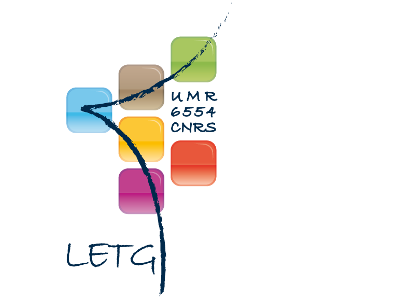
General framework of the activity
LETG-Nantes develops research on the analysis of coastal and maritime systems, by combining different geographical approaches (human, physical, geomatic). Its scientific program aims to contribute to knowledge on nature-society interactions through a modelling and integrative approach lying at the geographical interfaces between land, sea and atmosphere.
Specific skills in the MRE field
Dynamics and spatial interactions:
The main objective of the axis is to characterize precisely, spatially and temporally, the societal and environmental dynamics of the coastal strip at different scales of space and time. It is also to propose prospective scenarios of the observed impacts changes.
REMOTE SENSING – GEOMATICS:
Thematic research conducted by LETG involves complex dynamics occurring at different spatio-temporal scales. Therefore, methods must be developed for the exploitation of different kinds of numerical data, such as laboratory measurements (e.g. chemical composition) and in-situ field measurements (e.g. soil composition, meteorological data or object localization), images (in situ, aerial or satellite), LIDAR readings and digital spatial model outputs.
Spatial planning
The share between the different users of the sea is a key issue for the new MRE which must cohabited with pre-existing activities (fishing, aggregates, maritime transport, pleasure craft, activities of national navy, …) while respecting the constraints imposed by protected natural areas.
Projects in MRE
VALPENA
Spatialization of fishing activities has become a key issue in a context of sharing of space (marine renewable energies, extraction of aggregates, submarine cables, marine protected areas, etc.). Initiated in the Pays de la Loire (SMIDAP), the VALPENA project on evaluating fishing practices regarding new activities (2010-2013) aims to respond to this challenge by proposing an original methodology to build new spatialization data. Work initiated under the VALPENA project was continued under GIS VALPENA. Several projects were then proposed to the GIS: ESPADON (CNRS Littoral Challenge, 2016) and COP-VALPENA, (European Union / FEAMP measure 28). More information on: valpena.univ-nantes.fr
WEAMEC projects
The LETG lab lead the Data-Map project aiming at improving fisheries data processing and mapping to foster social licence for MRE.
The LETG-Nantes lab participates in the WEAMEC projects “PROSE” (characterization of the marine subsoil in relation to the development of MREs) and “HOOPLA” (characterization of the impacts of MRE activities on certain benthic fauna).
Training in the MRE field
The LETG-Nantes lab is involved in:
- WEAMEC continuous training “Maritime space, a shared space”.
- Master Geography and Spacial Planning – Course “Geography and Marine Spatial Planning”

